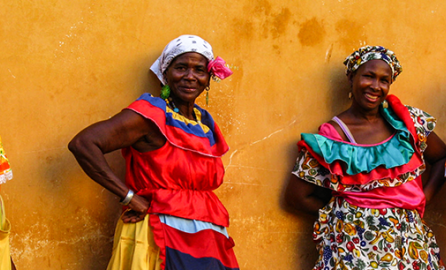From gender-based violence and harmful practices like female genital mutilation to social exclusion and low female participation in decision making processes, there is still a long way to achieving the Sustainable Development Goal 5 on gender equality and the empowering of women and girls.
|
What is the GAP II? The EU Gender Action Plan 2 (GAP II) provides the framework for the European Commission, the European External Action Services and the EU Member States in their approach to gender equality through external action. Its implementation is mandatory for all external relations of the EU and an implementation report of the GAP II is produced every year to monitor progress achieved. The GAP II has four thematic priorities: Ensuring girls’ and women’s physical and psychological integrity (6 sub-objectives) Promoting the economic and social rights / empowerment of girls and women (4 sub-objectives) Strengthening girls’ and women’s voice and participation (4 sub-objectives) Shifting the Commission services’ and the EEAS’ institutional culture to more effectively deliver on EU commitments. |
To promote gender equality and women’s empowerment in its own external relations, the EU has a framework known as the EU Gender Action Plan (GAP) II.
To accomplish the objectives, the GAP II is supported by Gender Focal Persons – in headquarters and at EU Delegations.
Their role is to oversee that all development programmes, projects and action documents deliver more effectively on the commitments towards gender equality and women’s and girls’ empowerment.
Three years into the implementation of GAP II, the EU development cooperation has seen an increase in quality and quantity of gender mainstreaming.
The women’s rights situation in Nicaragua is challenging, with the strong persistence of negative gender stereotypes. Photo © Mathieu-Etienne Gagnon/Oxfam
In our newest series, Capacity4dev has spoken to several Gender Focal Persons from EU Delegations around the world to collect experiences in implementing the GAP II and to find out how the framework has influenced their daily work.
Female genital mutilation in Guinea
We start off with the experience of the EU Delegation to Guinea. The West African country has some of the highest rates of female genital mutilation in the world, and the EU Delegation has used to the GAP II framework to sensitise the government authorities on the issue.
Gender stereotypes in Nicaragua
(full article to be published soon)
The women’s rights situation in Nicaragua is challenging, and the strong persistence of negative gender stereotypes make addressing them that much more difficult.
The Gender Focal Person at the EU Delegation to Nicaragua told us about a teambuilding exercise conducted in the context of the GAP II framework that aimed to address the stereotypes within the Delegation itself, and in turn, to prioritise the gender component of the engagements with local and international partners.
|
What is gender mainstreaming? Gender mainstreaming is the integration of the gender perspective into every stage of policy processes – design, implementation, monitoring and evaluation – with the aim of promoting equality between women and men. It means assessing how policies impact on the life and position of both women and men – and taking responsibility to re-address them if necessary. For more information visit Capacity4dev’s Public Group on Gender |
Women in Nigeria face several difficulties, including lack of economic empowerment and participation, and gender-based violence
Shifting institutional culture in Nigeria
(full article to be published soon)
Women in Nigeria face several difficulties, including lack of economic empowerment and participation, and gender-based violence.
The Gender Focal Person at the EU Delegation to Nigeria told us the GAP II has helped in increasing quality and quantity of gender mainstreaming and in placing the gender equality agenda at the very heart of the EU development cooperation in the country.
Gender analysis in Madagascar
(full article to be published soon)
Madagascar, off the coast of Africa, has a young and fast-growing population but women continue to face a range of challenges, from economic exclusion to low political participation.
The Gender Focal Person at the EU Delegation to the country told us how the GAP has fostered better coordination with the government and the EU Member States active in the country.
As a result of a brutal and ongoing conflict, some 2.2 million South Sudanese were forced to flee to neighboring countries, while 1.76 million remain internally displaced
Refugees and protracted crisis in South Sudan
(full article to be published soon)
As a result of a brutal and ongoing conflict, some 2.2 million South Sudanese were forced to flee to neighboring countries, while 1.76 million remain internally displaced. Among the most vulnerable groups are women and children.
Until recently, the EU Delegation to the country did not have a gender-focused approach. This changed with the release of the new GAP II framework. From including gender in calls for proposals to adhering to the GAP II minimum standards of performance, the EU Delegation has taken its first steps in ensuring that gender is included in all of its development cooperation.
Mainstreaming gender in Colombia
(full article to be published soon)
Colombia has made significant progress in promoting gender equality, but some problems remain endemic.
The Gender Focal Person described how the GAP II framework has helped ensure that gender-related issues are a priority for the EU development cooperation in the country. He provided examples of how gender can be mainstreamed in all daily aspects of the Delegation’s work.
|
Additional resources: Joint Staff Working Document "Gender Equality and Women's Empowerment: Transforming the Lives of Girls and Women through EU External Relations 2016-2020 (GAP II)" Capacity4dev Public Group on Gender DEVCO Academy Gender Page Sustainable Development Goal 5 "Achieve gender equality and empower all women and girls" |




Log in with your EU Login account to post or comment on the platform.